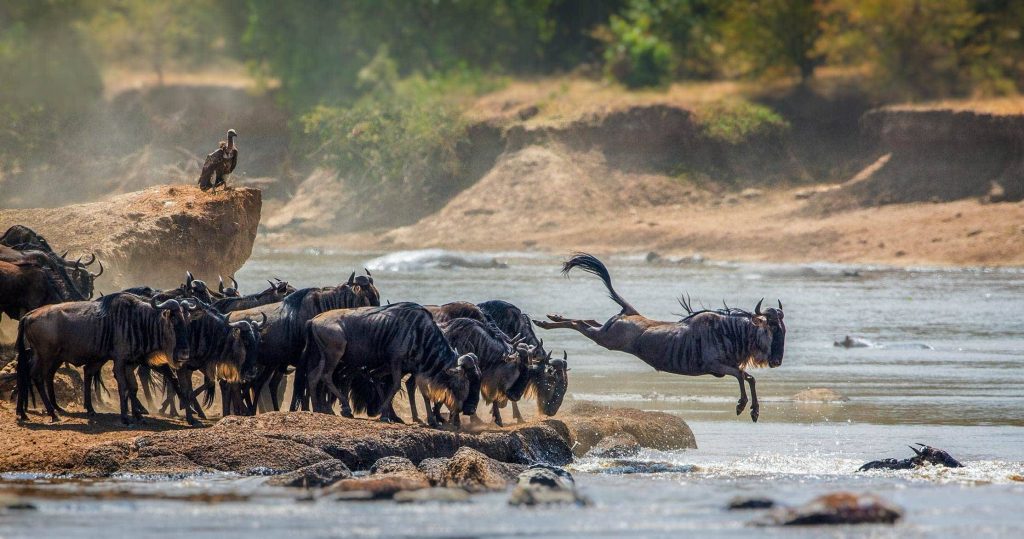Serengeti National Park
Serengeti national park

Serengeti National Park is Africa’s most famous park due to the largest concentration of game on the continent and the migration of millions of wildebeest. The most impressive nature documentaries were shot in this beautiful park. ‘Serengeti’ comes from the Maasai language meaning ‘endless plains’ and this rightly describes it. With almost 15,000 km2 (6,000 sq miles), Serengeti National Park is the second largest park in Tanzania.

Overview of Serengeti National Park:

Serengeti National Park is one of the most renowned wildlife sanctuaries in the world, celebrated for its incredible biodiversity and the dramatic spectacle of the Great Migration. This UNESCO World Heritage Site spans approximately 14,750 square kilometers and is located in northern Tanzania, bordering Kenya’s Maasai Mara.
The Great Migration:
The Serengeti is most famous for the Great Migration, where over 1.5 million wildebeest, 200,000 zebras, and 300,000 Thomson’s gazelles travel in a continuous cycle in search of fresh grazing and water. This epic journey is a breathtaking natural phenomenon that occurs annually and offers a unique opportunity to witness large-scale animal movements and predator-prey interactions.
The annual wildebeest migration of more than a million wildebeest is probably Serengeti’s main attraction. It is a truly impressive sight to see all those mammals thunder across the Serengeti plains, crossing rivers, in search of water and fresh grass. Mega herds on the move stretch up to 40Km long, covering a distance of some 1000 kilometers. A dangerous journey for the wildebeest, zebras and gazelles who need to outsmart their predators. Especially the Mara and Grumeti River is where giant crocodiles and fast flowing water awaits. The Great Migration is listed as one of the Seven Natural Wonders of the World and is for lots of visitors the highlight of their journey. It is definitely one of the world’s largest wildlife spectacles.
You can witness the wildebeest migration anytime of the year, since the animals migrate in a circle between the Serengeti and Masai Mara (Kenya). The exact timing of the Serengeti wildebeest migration depends upon the rainfall patterns each year. Thanks to our experienced Tanzania Specialist guides, we are able to make a fairly accurate prediction.
Diverse Wildlife:
Serengeti National Park offers so much more beauty than just the wildebeest migration. You can see a variety of landscapes and wildlife unlike anywhere else in Africa. The endless plains are home to more than 4,000 lions, 1,000 leopards, 225 cheetahs and 3,500 hyenas. It’s no surprise there are so many predators due to the abundance of wildebeest, zebras, gazelles and buffaloes. The Serengeti is also one of the best places to see the Big Five – rhino, buffalo, elephant, lion and leopard. Almost all the famous African animals are present in this majestic park. This includs rare animal species like the pangolin, East African Oryx, rhino and wild dog.
The captivating landscapes of the Serengeti National Park vary from savannahs with acacia trees and vast grasslands to rising mountains, lakes and swamps. Each area is unique and has its own atmosphere. Because of its natural beauty and variety of plants and animals the park is listed as UNESCO World Heritage Site. This place definitely touches your soul.
In addition to the migrating herds, the Serengeti is home to a rich variety of wildlife. Visitors can encounter the Big Five (lion, leopard, elephant, buffalo, and rhino) along with cheetahs, hyenas, giraffes, hippos, crocodiles, and numerous bird species.
Travel Time To Serengeti National Park
- Arusha to Serengeti: 6 hours’ drive.
- Ngorongoro to Serengeti: 3 hours’ drive.
- Lake Manyara to Serengeti: 4 hours’ drive.
- Tarangire to Serengeti: 5 hours’ drive.
- Flight Arusha to Serengeti: 1 hour
Varied Landscapes:
How long to stay?
At least 2 days, but some guests would say even a week is not enough.
Facts about Serengeti National Park
- Endless plains with typical Lion King trees
- Calving season in February, when 8.000 wildebeest calves are born each day
- Simba Kopjes are granite outcroppings where lions like to rest
- Seronera River is a valuable water source and attracts lots of wildlife.
- Retina Hippo Pool, home to about 200 hippos
- Grumeti River and Mara River, famous for the wildebeest river crossings.
- Lobo Valley, great views of elephants and big cats.
Most common animals
- Lions
- Cheetahs
- Leopards
- Wildebeest (more than 1 million)
- Zebras (more than 200.000)
- Gazelles (more than 300.000)
- Rhinos
- Elephants
- Crocodiles
- Hippos
- Grant Gazelle
- Thomson Gazelle
